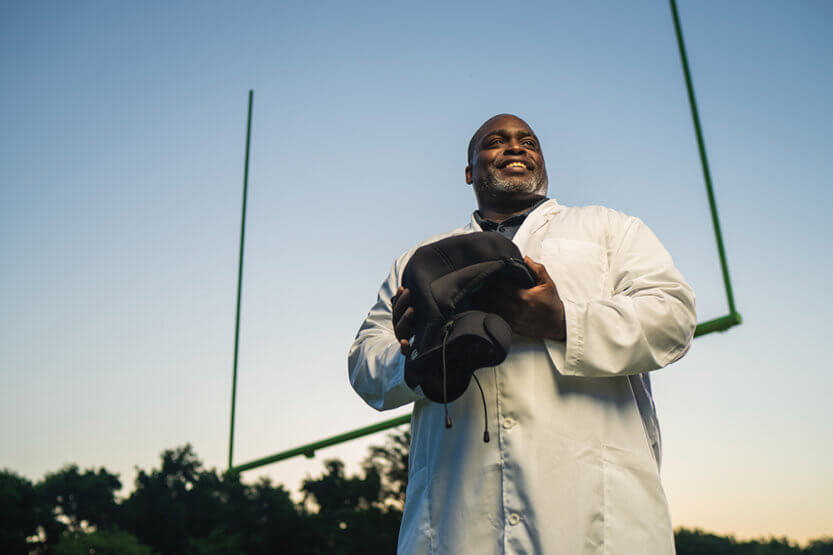Alumni Interview: Kevin Jackson
 “But for millions of young people, high school or college sports are the end of the line. After that, you need a new identity.”
Kevin Jackson, ’95 ACES,
MS ’99 ACES, PHD ’03 ACES (Image by Nathan Morgan)
“But for millions of young people, high school or college sports are the end of the line. After that, you need a new identity.”
Kevin Jackson, ’95 ACES,
MS ’99 ACES, PHD ’03 ACES (Image by Nathan Morgan) When I arrived at Illinois in 1990, a kid out of a tough neighborhood south of Chicago, I had no idea I’d become a research scientist. I was a football player who felt blessed to join the Big Ten champions, a team captained by future NASA astronaut Mike Hopkins, ’92 ENG, with a couple of other running backs ahead of me on the depth chart: Howard Griffith, ’91 LAS, who would go on to an eight-year NFL career, and Kameno Bell, ’92 LAS, MD ’01 UIC, who went on to be the New York Giants’ team doctor.
More than 30 years later, I’m proud to be part of Illini football history: 928 all-purpose yards, including a 125-yard game against Purdue and a 47-yard run against Northwestern at Memorial Stadium. That play had me flashing back to childhood games of tag—I covered almost half the field with 11 guys chasing me!
But my football days ended when I graduated. Like the vast majority of college players, I wasn’t an NFL prospect.
I was luckier than that.
Thanks to biotechnology professor Matt Wheeler, who became my mentor, I wound up spending more time in labs than I ever spent on the football field. With his help, I landed a $4,000 research grant from Pfizer—an enormous sum for a kid with no money or connections outside the University. I spent a summer learning how to freeze pig embryos, and went on from there to a study of endometriosis on baboons.
That led in turn to my current work at PPD Inc., part of Thermo Fisher Scientific, a global leader in testing new drugs that could eventually save millions of human lives. I like to say that with a boost from Professor Wheeler, I’ve gone from pigskin to pigs to primates to people to PPD!
One track of my career had to do with an issue you’ve heard about: football concussions. I was struck by the fact that concussion symptoms and heat stroke symptoms are similar—wooziness, nausea, blurred vision—and the two often happen at the same time. Does heat make concussions worse? Could we help concussed athletes recover by keeping their brains from overheating? With neurosurgeon Dr. Huan Wang and Bill Elkins in the lead, I helped develop a head-and-neck cooling device that helps cool the brain. I’ve since stepped away from that research to focus on cancer studies, but I think it holds promise for a younger generation of athletes who share my love of the game.
With inspiration from [my mother and sister], plus hard work and help from friends and colleagues like Matt Wheeler—my mentor till the day I die—I’ve made the transition from football player to scientist. Here’s hoping a new generation of U of I athletes go on to careers they love as much as I love mine.
Meanwhile, I’d like to see the U of I continue being a leader in sports science. We’ve got two MRI scanners at the Beckman Institute. Why not use them to test athletes when they arrive on campus, when they leave, and later in life? There would be costs involved—diagnostic MRIs cost $1,000 and up—but such a program might be worth the expense.
The first tests would establish a baseline; the others would provide data on how different sports can affect players’ brains and bodies. Athletes’ long-term health may be sports science’s next frontier. Research like that might save careers or even lives in the long-run.
And that includes their mental well-being. If today’s young athletes are like me—and I know many who are—they reach college thinking of themselves mostly in terms of their sports. “I’m a gymnast. I’m a goalie. I’m a football player.” That’s how I thought of myself from the age of eight or nine to the end of my college career. But for millions of young people, high school or college sports are the end of the line. After that, you need a new identity.
I’ve been working with Associate Athletic Director Randy Ballard on ways to help athletes make the transition from sports to “real life.” It’s a fascinating subject and another way to give something back to the University that changed my life.
My passion for science dates back even further—to my boyhood dream of helping my mother and sister. Both of them were diabetic and died from complications of the disease. My current work isn’t directly related to diabetes, but my career path sure is.
With inspiration from them, plus hard work and help from friends and colleagues like Matt Wheeler—my mentor till the day I die—I’ve made the transition from football player to scientist. Here’s hoping a new generation of U of I athletes go on to careers they love as much as I love mine.

